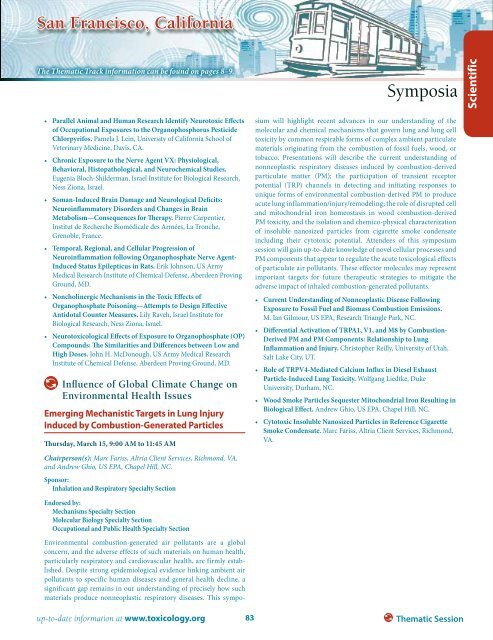51st Annual Meeting & ToxExpo - Society of Toxicology
51st Annual Meeting & ToxExpo - Society of Toxicology
51st Annual Meeting & ToxExpo - Society of Toxicology
You also want an ePaper? Increase the reach of your titles
YUMPU automatically turns print PDFs into web optimized ePapers that Google loves.
San Francisco, California<br />
The Thematic Track information can be found on pages 8–9.<br />
• Parallel Animal and Human Research Identify Neurotoxic Effects<br />
<strong>of</strong> Occupational Exposures to the Organophosphorus Pesticide<br />
Chlorpyrifos. Pamela J. Lein, University <strong>of</strong> California School <strong>of</strong><br />
Veterinary Medicine, Davis, CA.<br />
• Chronic Exposure to the Nerve Agent VX: Physiological,<br />
Behavioral, Histopathological, and Neurochemical Studies.<br />
Eugenia Bloch-Shilderman, Israel Institute for Biological Research,<br />
Ness Ziona, Israel.<br />
• Soman-Induced Brain Damage and Neurological Deficits:<br />
Neuroinflammatory Disorders and Changes in Brain<br />
Metabolism—Consequences for Therapy. Pierre Carpentier,<br />
Institut de Recherche Biomédicale des Armées, La Tronche,<br />
Grenoble, France.<br />
• Temporal, Regional, and Cellular Progression <strong>of</strong><br />
Neuroinflammation following Organophosphate Nerve Agent-<br />
Induced Status Epilepticus in Rats. Erik Johnson, US Army<br />
Medical Research Institute <strong>of</strong> Chemical Defense, Aberdeen Proving<br />
Ground, MD.<br />
• Noncholinergic Mechanisms in the Toxic Effects <strong>of</strong><br />
Organophosphate Poisoning—Attempts to Design Effective<br />
Antidotal Counter Measures. Lily Raveh, Israel Institute for<br />
Biological Research, Ness Ziona, Israel.<br />
• Neurotoxicological Effects <strong>of</strong> Exposure to Organophosphate (OP)<br />
Compounds: The Similarities and Differences between Low and<br />
High Doses. John H. McDonough, US Army Medical Research<br />
Institute <strong>of</strong> Chemical Defense, Aberdeen Proving Ground, MD.<br />
Influence <strong>of</strong> Global Climate Change on<br />
Environmental Health Issues<br />
Emerging Mechanistic Targets in Lung Injury<br />
Induced by Combustion-Generated Particles<br />
Thursday, March 15, 9:00 AM to 11:45 AM<br />
Symposia<br />
Environmental combustion-generated air pollutants are a global<br />
concern, and the adverse effects <strong>of</strong> such materials on human health,<br />
particularly respiratory and cardiovascular health, are firmly established.<br />
Despite strong epidemiological evidence linking ambient air<br />
pollutants to specific human diseases and general health decline, a<br />
significant gap remains in our understanding <strong>of</strong> precisely how such<br />
materials produce nonneoplastic respiratory diseases. This symposium<br />
will highlight recent advances in our understanding <strong>of</strong> the<br />
molecular and chemical mechanisms that govern lung and lung cell<br />
toxicity by common respirable forms <strong>of</strong> complex ambient particulate<br />
materials originating from the combustion <strong>of</strong> fossil fuels, wood, or<br />
tobacco. Presentations will describe the current understanding <strong>of</strong><br />
nonneoplastic respiratory diseases induced by combustion-derived<br />
particulate matter (PM); the participation <strong>of</strong> transient receptor<br />
potential (TRP) channels in detecting and initiating responses to<br />
unique forms <strong>of</strong> environmental combustion-derived PM to produce<br />
acute lung inflammation/injury/remodeling; the role <strong>of</strong> disrupted cell<br />
and mitochondrial iron homeostasis in wood combustion-derived<br />
PM toxicity, and the isolation and chemico-physical characterization<br />
<strong>of</strong> insoluble nanosized particles from cigarette smoke condensate<br />
including their cytotoxic potential. Attendees <strong>of</strong> this symposium<br />
session will gain up-to-date knowledge <strong>of</strong> novel cellular processes and<br />
PM components that appear to regulate the acute toxicological effects<br />
<strong>of</strong> particulate air pollutants. These effector molecules may represent<br />
important targets for future therapeutic strategies to mitigate the<br />
adverse impact <strong>of</strong> inhaled combustion-generated pollutants.<br />
• Current Understanding <strong>of</strong> Nonneoplastic Disease Following<br />
Exposure to Fossil Fuel and Biomass Combustion Emissions.<br />
M. Ian Gilmour, US EPA, Research Triangle Park, NC.<br />
• Differential Activation <strong>of</strong> TRPA1, V1, and M8 by Combustion-<br />
Derived PM and PM Components: Relationship to Lung<br />
Inflammation and Injury. Christopher Reilly, University <strong>of</strong> Utah,<br />
Salt Lake City, UT.<br />
• Role <strong>of</strong> TRPV4-Mediated Calcium Influx in Diesel Exhaust<br />
Particle-Induced Lung Toxicity. Wolfgang Liedtke, Duke<br />
University, Durham, NC.<br />
• Wood Smoke Particles Sequester Mitochondrial Iron Resulting in<br />
Biological Effect. Andrew Ghio, US EPA, Chapel Hill, NC.<br />
• Cytotoxic Insoluble Nanosized Particles in Reference Cigarette<br />
Smoke Condensate. Marc Fariss, Altria Client Services, Richmond,<br />
VA.<br />
Scientific<br />
Chairperson(s): Marc Fariss, Altria Client Services, Richmond, VA,<br />
and Andrew Ghio, US EPA, Chapel Hill, NC.<br />
Sponsor:<br />
Inhalation and Respiratory Specialty Section<br />
Endorsed by:<br />
Mechanisms Specialty Section<br />
Molecular Biology Specialty Section<br />
Occupational and Public Health Specialty Section<br />
up-to-date information at www.toxicology.org 83<br />
Thematic Session
















